Your neck pain is debilitating. Medications, therapy, and other conservative treatments have failed to provide any relief. Your doctor is recommending surgery. What is Cervical Fusion Surgery? What are the different types of Cervical Fusion Surgery? What are the indications for Cervical Fusion Surgery? What are the risks associated with Cervical Fusion Surgery? What are the 9 major causes of muscle pain after Cervical Fusion Surgery? Is there an alternative to Cervical Fusion Surgery? Let’s dig in.
What Is Cervical Fusion Surgery?
Cervical Fusion is a major surgery that involves joining one or more of the spinal bones together using screws, bolts, and plates (1). The hardware may be placed in the front (anterior) or the back( posterior) of the cervical spine. The disc between the spinal bones is often times removed and replaced with a bone graft or a spacer.
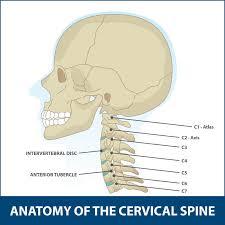
The neck of composed of 7 boney building blocks that are numbered from 1-7. The letter C is associated with the numbers to designate the cervical spine. Hence the bones in the neck are C1 through C7. Sandwiched between neck bones are important shock absorbers called discs. A Cervical Fusion Surgery removes this important shock absorber and joins the adjacent bones together with hardware. To learn more about this, check out our blog post “Life After Three Level Cervical Fusion Surgery.”
Are there Different Types of Cervical Fusion Surgery?

Side View X-Ray of Anterior Cervical Fusion.
There are many different types of Cervical Fusion surgeries. They can be easily categorized by surgical approach and number of levels treated. The surgical approach identifies the approach utilized by the surgeon to access the discs. There are two principal approaches:
Anterior (FRONT)
The surgeon removes the discs through an incision in the front of the neck. Removal of the disc is called a discectomy. The screws and plates are placed on the front of the neck. This type of surgery is commonly referred to as ACDF (Anterior Cervical Discectomy and Fusion)
Posterior (BACK)
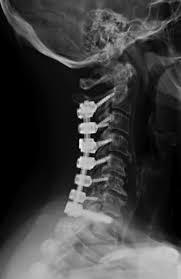
Side View X-ray of Posterior Cervical Fusion
During a posterior fusion, the surgeon removes the discs through an incision in the back of the neck. The screws and plates are placed in the back of the neck. This type of surgery is commonly referred to as a PCF (Posterior Cervical Fusion). This approach requires the removal of important spinal bones in addition to the disc called the lamina. The lamina provides critical support and protection of the spinal cord.
Cervical Fusion Surgery may involve one or more affected discs. For example, a three-level fusion is a major surgery where three cervical discs are removed and hardware is placed to stabilize the neck.
Cervical Fusion is a popular surgery. The rate of posterior Cervical Fusions in the US has increased by 2.7 fold from 2001-2013 (2).
Indications for Cervical Fusion Surgery
There are many indications for Cervical Fusion. The most common include:
Tumors
Spinal Bone Fractures
Infections (Osteomyelitis)
Narrowing of the Spinal Canal (Stenosis)
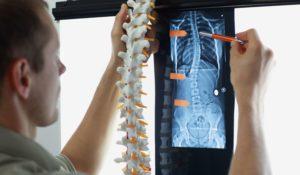
A curve in the spine is called Scoliosis
Trauma
Spinal Cord Injury
Curves in the Spine (Scoliosis)
Severe Arm Pain with Numbness and Tingling (radiculopathy)
Painful Disc
Are there Risks Associated with Cervical Fusions?
Cervical Fusion is a major surgery associated with risks. The most common immediate risks include:
Infection
Infection is a devastating complication and was found to occur in 16.6% of patients in a recent study (3). Infection may involve the skin or deeper structures such as the bone. The latter is a serious complication often times requiring additional surgery.
Excessive Bleeding
The neck is rich in blood vessels which can be cut or injured resulting in significant bleeding. Bleeding can occur while in surgery or hours to days thereafter. When uncontrolled additional surgery may be required.
Difficulty Swallowing

Difficulty swallowing is called dysphagia and can occur after neck fusion. The incidence of dysphagia after Cervical Fusion Surgery in one study was 12.7% (4). Difficulty swallowing can compromise calorie, fluid intake, and healing.
Reaction of Anesthesia
Cervical Fusion is a major surgery that requires a general anesthetic. The procedure takes 1-3 hours depending upon the number of levels treated and the surgical approach. The risks of general anesthesia include nausea, vomiting, allergic reaction to anesthetic medicines, respiratory depression, and reduced blood pressure and heart rate. General anesthesia is associated with an increased risk of dementia (5).
Spinal Fluid Leak (CSF)
The dura is the outermost membrane that covers the brain and spinal cord. This important membrane can be punctured during surgery causing a leak of spinal fluid. The incidence ranges from 1-17% (6). Severe headache is a common symptom of Dural Leak. If left untreated, a spinal fluid leak can lead to infection, brain abscess, and bleeding (7).
9 Causes of Muscle Pain after Cervical Fusion Surgery
Neck Instability
During Cervical Fusion Surgery, your supporting ligaments are damaged or removed. Ligaments are thick pieces of connective tissue that connects bone to bone. They provide important stability. When damaged your remaining neck muscles are called upon to support the neck. When overloaded the neck muscles cause muscle pain.
Incorrect Diagnosis
Often times physicians place significant weight on the MRI findings. For example, if a patient’s neck MRI shows a large disc protrusion or herniation many providers conclude that the disc is the ‘source of the pain’. When conservative care fails, surgery is oftentimes performed. Regrettably, for some patients who undergo Cervical Fusion Surgery, the pain persists. Why? The exact source of the pain was not clearly identified before surgery. The disc may have been the source of the pain. A complete and thorough investigation of all potential sources of neck pain must be performed prior to surgery. A physician trained in Interventional Orthopedics is best suited to provide such an evaluation. To find one click here.
Nerve Injury
Nerves can be damaged during surgery and the incidence varies from 0.18% to 2.6% (8). This can cause a compromise or a delay in the electrical signal from the nerve to muscles. The result can be muscle weakness, cramping, and muscle pain.
Failed Fusion
This is BAD news. It means that despite the surgery, the inserted screws and plates, the extensive rehabilitation, and the pain you endured the spinal bones did not fuse. Failure of the bones to fuse is called non-union or pseudoarthrosis. The incidence of non-union is striking and in one study was found to be 52% (9). The consequences are significant as failed fusion causes restricted movement and pain. The treatment involves another surgery where the fusion is revised and oftentimes the fusion is extended up or down an additional level. Failed fusion is a frequent cause of muscle pain after Cervical Fusion Surgery.
Adjacent Segment Disease
Adjacent Segment Disease (ASD) is a common complication of neck fusion with an incidence of 21% (10). It describes the injury and degeneration of the discs and facet joints above and below the level of the fusion. It is a direct result of Cervical Fusion Surgery. Why? The discs in our necks are designed to absorb the forces of daily living. Fusing one or more discs together results in additional forces being placed on the disc and facet joints above and below the fusion. This additional pressure results in wear and tear and degeneration often times requiring additional surgery. To learn more please see our video below:
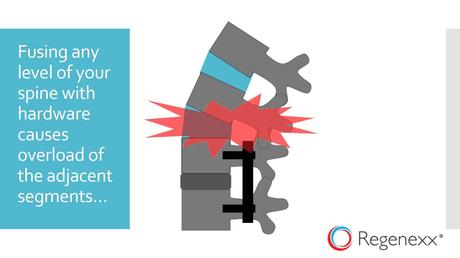
Damaged or Stretched Neck Muscles
Cervical Fusion Surgery involves removing the damaged disc or discs, filling the void with bone or a spacer, and stabilizing the spine with plates and screws. This involves pulling the muscles to the side in order to gain access to the discs. The muscles can become damaged or stretched resulting in muscle pain after cervical fusion surgery.
Shoulder Injury
New-onset shoulder pain can occur in patients who undergo Cervical Fusion Surgery. The level of the fusion and surgical approach is important. Patients that had lower neck fusions ( C4-T1) with a posterior approach were more likely to have shoulder pain after fusion surgery (11). Ouch. You go in for one problem and come out with a new separate one. Muscle pain after Cervical Fusion Surgery may be due to a new shoulder injury.
Incorrect Screw Placement
Screws and plates are utilized to stabilize the neck during Cervical Fusion Surgery. The screw can be inserted incorrectly and advanced into a nerve or facet joint causing pain and weakness. Muscle pain after cervical fusion surgery may be due to incorrect hardware placement. The solution oftentimes involves another surgery.
Poor Posture
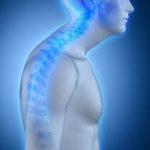
A normal, healthy neck has a gentle C-shaped curve which is often referred to as a lordotic curve (12). Surgery typically results in loss of this curve. This has significant clinical consequences. Why? Because the bones, tendons, and ligaments in the neck are no longer in alignment which places them at risk for injury and becoming a source of pain. The thoracic spine may also be affected. Kyphosis is a spinal condition also known as hunchback characterized by exaggerated, forward rounding of the back. Kyphosis has an incidence of 20% after multilevel cervical surgery (13). Muscle pain after Cervical Fusion Surgery may be due to loss of cervical curve and new-onset kyphosis.
How to Avoid These Complications?
The best way to avoid the significant risks, complications of fusion surgery is to avoid having Cervical Fusion in the first place. Is there any alternative? Absolutely!
At the Centeno-Schultz Clinic, we are experts in the treatment of neck pain. We are the leaders in the field of regenerative medicine and interventional orthopedics. We were the first clinic in the world to inject stem cells into the lumbar disc. We have published extensively in recognized, peer-reviewed journals. Our list of publications is available here. How patients fare after a procedure is important. For that reason, we track patient outcomes over multiple time points. To see our outcomes please click here.
Treatment options include specialized PRP, bone marrow stem cells, adipose grafts, At the Centeno-Schultz Clinic, all injections are performed under x-ray or ultrasound guidance. This ensures that PRP and or stem cells are accurately placed into the damaged areas. Blind injections are not acceptable and are below our standard of care. With blind injections, there is no assurance that the PRP or cells were actually injected into the targeted tissue. The injections are challenging and can not be performed by your surgeon, chiropractor, or physician assistant. To watch a Centeno-Schulz Clinic injection click on the video below.
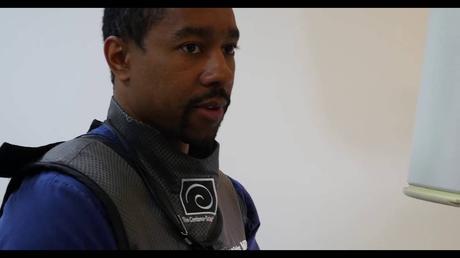
In Conclusion
Cervical Fusion is a major surgery that involves joining one or more of the spinal bones together using screws, bolts, and plates. There are different types of Cervical Fusion Surgery categorized by surgical approach and the number of levels treated. There are many indications for Cervical Fusion Surgery. The most common include tumors, spinal bone fractures, infections, stenosis, spinal cord injury, severe arm pain, and pain arising from the disc. The immediate risks associated with Cervical Fusion include infection, excessive bleeding, difficulty swallowing, reaction to anesthesia, and spinal fluid leak. The 9 major causes of muscle pain after Cervical Fusion include:
- Neck Instability
- Incorrect Diagnosis
- Nerve Injury
- Failed Fusion
- Adjacent Segment Disease
- Damaged or Stretched Neck Muscles
- Shoulder Injury
- Incorrect Hardware Placement
- Poor Posture
The best way to avoid these complications is to avoid having neck surgery. Are there alternatives to Cervical Fusion Surgery? Absolutely. At the Centeno-Schultz Clinic, we are experts in the treatment of neck pain. Specialized PRP and stem cells are effective alternatives to Cervical Fusion and are not associated with the significant risks and complications discussed above.
If you or a loved one has ongoing neck pain that has responded to conservative and medication therapy please schedule a telephone candidacy with a board-certified, fellowship train physician. From the comfort of your home or cabin learn what treatment options are available for you. Call today and stop the pain and suffering. Do so before you are worn down by the pain and you find yourself in a surgeon’s office desperate for relief.
1.Srikhande NN, Kumar VAK, Sai Kiran NA, et al. Clinical presentation and outcome after anterior cervical discectomy and fusion for degenerative cervical disc disease. J Craniovertebr Junction Spine. 2019;10(1):28-32. doi:10.4103/jcvjs.JCVJS_87_18
2.Youssef JA, Heiner AD, Montgomery JR, Tender GC, Lorio MP, Morreale JM, Phillips FM. Outcomes of posterior cervical fusion and decompression: a systematic review and meta-analysis. Spine J. 2019 Oct;19(10):1714-1729. doi: 10.1016/j.spinee.2019.04.019. Epub 2019 May 7. PMID: 31075361.
3.Barnes M, Liew S. The incidence of infection after posterior cervical spine surgery: a 10 year review. Global Spine J. 2012;2(1):3-6.doi: 10.1055/s-0032-1307252
4.De la Garza-Ramos R, Xu R, Ramhmdani S, Kosztowski T, Bydon M, Sciubba DM, Wolinsky JP, Witham TF, Gokaslan ZL, Bydon A. Long-term clinical outcomes following 3- and 4-level anterior cervical discectomy and fusion. J Neurosurg Spine. 2016 Jun;24(6):885-91. doi: 10.3171/2015.10.SPINE15795. Epub 2016 Feb 19. Erratum in: J Neurosurg Spine. 2016 Jun;24(6):996. PMID: 26895527.
5.Kim CT, Myung W, Lewis M, Lee H, Kim SE, Lee K, Lee C, Choi J, Kim H, Carroll BJ, Kim DK. Exposure to General Anesthesia and Risk of Dementia: A Nationwide Population-Based Cohort Study. J Alzheimers Dis. 2018;63(1):395-405. doi: 10.3233/JAD-170951. PMID: 29614656.
6.Tosun B, Ilbay K, Kim MS, Selek O. Management of Persistent Cerebrospinal Fluid Leakage Following Thoraco-lumbar Surgery. Asian Spine J. 2012;6(3):157-62. doi: 10.4184/asj.2012.6.3.157.
7.Fang Z, Tian R, Jia YT, Xu TT, Liu Y. Treatment of cerebrospinal fluid leak after spine surgery. Chin J Traumatol. 2017;20(2):81-3.doi: 10.1016/j.cjtee.2016.12.002.
8.Cheung JP, Luk KD. Complications of Anterior and Posterior Cervical Spine Surgery. Asian Spine J. 2016;10(2):385-400.doi: 10.4184/asj.2016.10.2.385
9.https://medicalxpress.com/news/2018-10-pseudarthrosis-single-level-acdf-peek-interbody.html
10.Wu XD, Wang XW, Yuan W, et al. The effect of multilevel anterior cervical fusion on neck motion. Eur Spine J. 2012;21(7):1368-1373. doi:10.1007/s00586-012-2157-7
11.Kholinne E, Kwak JM, Sun Y, Lee HJ, Koh KH, Jeon IH. Risk Factors for Persistent Shoulder Pain After Cervical Spine Surgery. Orthop Surg. 2019;11(5):845-849. doi:10.1111/os.12531.
12.Lippa L, Lippa L, Cacciola F. Loss of cervical lordosis: What is the prognosis?. J Craniovertebr Junction Spine. 2017;8(1):9-14. doi:10.4103/0974-8237.199877
13..Kaptain GJ, Simmons NE, Replogle RE, Pobereskin L. Incidence and outcome of kyphotic deformity following laminectomy for cervical spondylotic myelopathy. J Neurosurg. 2000 Oct;93(2 Suppl):199-204. doi: 10.3171/spi.2000.93.2.0199. PMID: 11012049.

